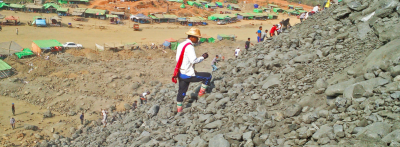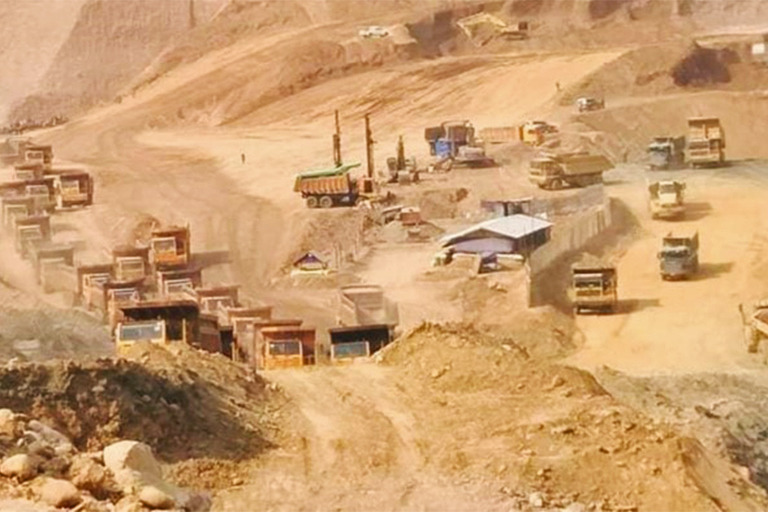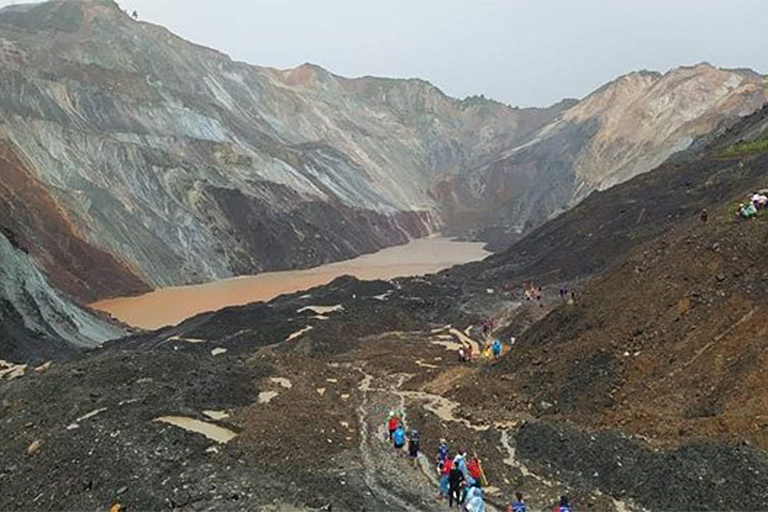Analysis: Myanmar’s Gemstone Riches Bring Poverty and Environmental Destruction

All Global Research articles can be read in 51 languages by activating the “Translate Website” drop down menu on the top banner of our home page (Desktop version).
To receive Global Research’s Daily Newsletter (selected articles), click here.
Visit and follow us on Instagram, Twitter and Facebook. Feel free to repost and share widely Global Research articles.
***
On Feb. 28, a landslide of earth and waste from mines in Myanmar’s Hpakant township engulfed dozens of miners and scavengers looking for jade in this remote, mountainous region. Official sources claim just two deaths resulted from the landslide, but residents and aid workers said at least 23 people were killed and 80 missing.
The fatal landslide earlier this year is just the latest in a series of deadly disasters in Hpakant, where no mining has occurred legally since 2020: at least three people were killed in a December 2021 landslide, while a 2020 landslide claimed 162 lives and another in 2015 killed 113.
Myanmar produces a wide range of high-quality gems and precious stones: jade, ruby, sapphire, spinel, diamond, tourmaline, peridot, topaz, garnet, moonstone, lapis lazuli, chrysoberyl, amber and quartz. Yet, despite the production of numerous gems, mismanagement and corruption in the industry ensure that the country remains economically underdeveloped and suffers from social and environmental deterioration.

Jade and gemstone market in Mandalay. Image by John Sai Luu.
Risky business
Most of the country’s gemstone-mining sites are located in conflict areas such as Kachin state’s Hpakant area and Khamti township in the Sagaing region, where ethnic minority groups are waging armed struggles against the Myanmar government.
Jade from Myanmar, famous in the global market and especially prized by Chinese consumers, is primarily produced in Hpakant, a mountainous township in the northernmost part of Myanmar.
According to a local charity organization in Hpakant, more than 500 people have been killed in landslides since 2015. This string of fatalities is the result of a deadly combination of corruption, poor environmental management, conflict, and economic desperation. As the country battles an economic downturn and rising unemployment, people from across Myanmar flock to Hpakant hoping to scavenge gems left behind by large mining operations.
“Since the country’s economy is not functioning well, many people come to Hpakant, hoping to make riches from rags,” says Hpakant resident Ko Sai Han. “Dying during landslides becomes more common. I also have to run for my life when there’s a landslide. People are betting on their lives while searching for gemstones at the dumpsite. These problems will continue as long as there is mining. The gemstone mines in Myanmar only benefit a handful of people but not the local people like us.”
According to 2016 report of Myanmar Gems and Jewelry Enterprise, there were 21,000 gemstone mines in Hpakant and Khamti. In Hpakant alone, there are more than 500 companies mining using heavy machinery.

Companies use heavy machinery at jade mining sites in Hpakant. Image by John Sai Luu.
Endemic corruption
To obtain a permit, mining companies have to pay fees to the mining ministry, as well as local authorities. These fees are vary depending on the size of a concession and its estimated gem reserves. However, the exact figures are a secret, and companies refuse to disclose how much they have paid, citing confidentiality agreements they have to sign with authorities. Corruption is rampant at every level in the process, and failure to pay kickbacks to the ministry and local authorities can cause unnecessary delays in getting a permit.
Myanmar’s Mining Law requires both authorities and miners to follow specific environmental conservation protocols, but enforcement is weak. In Hpakant, all mining licenses for companies expired in 2019 and 2020. Officially, the ruling junta has not granted mining licenses since the February 2021 coup. However, mining continues.
Moreover, the Kachin Independence Army (KIA), an ethnic armed organization, controls some of the mine sites in Hpakant. An employee of a jade mining company, speaking on condition of anonymity for security reasons, says companies have to pay the KIA 10% of the total profit of mining sites under its control. As a result of deals like these, resource extraction is also a source of the conflict between the Myanmar army and ethnic armed groups.
“No jade mining license has been granted. But some people continue mining,” said another miner, also speaking on condition of anonymity. “Now, there are only Tatmadaw [Myanmar Armed Forces] and KIA. The mining continues under informal agreement, meaning you can continue if you have an understanding with them. Illegal mining was not fully regulated before. But now, illegal mining has become worse.”
Regardless of the specifics of their arrangement, companies have a limited period during which they can mine. As a result, they move as fast as they can, excavating mountainsides with heavy machinery, carving out massive man-made valleys and discarding the waste into huge piles. The speed and scale at which companies operate not only causes environmental damage, but also means that even high-quality gems may be missed, making these mining dumpsites a tempting target for scavengers.
In addition to the environmental problems it causes, the jade mining boom in Hpakant has brought with it a host of social and public health problems. Illegal drugs such as heroin, methamphetamines and opium are easily available in Hpakant. Some drug use is recreational, but the use of stimulants and analgesics allows miners and scavengers to endure long, brutal stints searching for gems. Intravenous drug use is also a driver of HIV transmission.
“Drugs are easy to find in Hpakant, just as jade is,” said a Hpakant resident, who also requested anonymity. “Many people got addicted while using drugs for fun. Before, local organizations against drug abuse could do actions against drug abuse. But now with pandemic and political instability, they can’t do much. Drug problems will continue as long as there are gemstone mines.”

Excessive mining of jade has caused occasional landfalls and sinkholes in Hpakant. Image by John Sai Luu.
Resource and conflict
“Our area produces jade, but local people don’t benefit from jade mining,” said Hpakant resident Ko Naw Aung. “Local people made their living scavenging jade in the land dumpsite. The area is far from being developed because jade mining only benefits a handful of people. In fact, plenty of development works can be carried out using revenue earned from resource extraction. Years have passed, but the lives of local people remain the same.”
The same observation can be extended to the country as a whole. Despite its rich resources, Myanmar is struggling from both environmental deterioration and economic problems caused by conflict and a weak political system — a scenario often referred to as the resource curse. The promise of wealth from gems and other natural resources has driven a cycle of conflict and instability, rather than providing employment and funding investments that could improve citizens’ quality of life.
Myanmar’s government stands to derive significant revenue from jade mining. In addition to the share of profits agreed upon when a company is granted a mining concession, the government imposes taxes of 15-20% on jade and gems sold at emporiums. According to the Myanmar Extractive Industries Transparency Initiative (MEITI), the government received 708 billion kyat ($578 million) from jade and gems companies in the 2015-16 fiscal year.
However, this likely represents just a small portion of the true value of jade sales. The high tax motivates companies to underreport or undervalue their production. Many companies evade taxes by making covert payments to regulators.
The profits from the industry thus go to a handful of individuals, instead of contributing to national economic growth. It’s an open secret that the bulk of the revenue from jade mining and other forms of resource extraction flows into the pockets of corrupt officials and their cronies, as well as the Myanmar army and various armed non-state entities.
During the period of civilian rule from 2011 to 2021, lawmakers made some efforts to bring accountability to the sector and ensure revenue from mining went into the public budget. For example, in 2016, during the Thein Sein government, officials were dismissed from the customs department and commerce ministry for allowing mining vehicles to be illegally imported to Hpakant from China. Under the junta, even these small efforts have vanished.

Manual mining sites in Myanmar’s ruby heartland of Mogok. Image by John Sai Luu.
The production of jade and gems is currently in decline due to both COVID-19 and political turmoil in the wake of the 2021 coup. There have been fewer international jade and gems emporiums as a result.
“The jade and gems business is slow in Myanmar,” said jade and gems merchant U Win Maung. “The major buyer is China. Chinese buyers are pushing prices down, taking advantage of the political situation in Myanmar. We don’t have many options, so we have to sell at the prices they offer.”
Jade that isn’t sold at emporiums generally ends up being smuggled into China. But while mining companies evade government taxes, it doesn’t mean they aren’t paying fees for their extraction and export. As mines are located in contested areas and areas controlled by the Kachin Independence Army, they have to pay fees to the KIA as well as the government-backed militias that control the smuggling routes. And Myanmar’s military and the border guard are also involved in this widespread ring of corruption.
The fact that Myanmar lacks the technology to produce finished products from raw jade suits gem buyers in China. Myanmar has had to rely on China in political, economic and various other fields for decades. As a consequence, Myanmar’s jade and gems industry will remain a buyer’s market for China for many more years to come.
“Among other resources, jade and gemstones generate most of the revenue,” one anonymous gemstone expert said. “Our country is a resource-producing country. We need to go from producing raw materials to finished products. We need to make sure the resource-extracting industry benefits the local communities. Gemstone markets need to be built to benefit local people. To do that, everyone needs to work together. Because of the weak mechanism, local communities are not benefiting from resource extracting industry. It is important to install responsibility, accountability and transparency mechanism in the industry.”
*
Note to readers: Please click the share buttons above or below. Follow us on Instagram, Twitter and Facebook. Feel free to repost and share widely Global Research articles.
Featured image: A jade mining site in Myanmar’s Kachin state. Image by Yin_Min_Tun via Wikimedia Commons (CC BY-SA 3.0).

